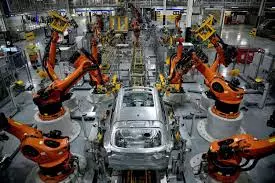AA Edit | Centre Needs To Take Lead To Kickstart The Economy
According to data released by the ministry of statistics and programme implementation (MoSPI), the manufacturing sector grew by 4.5 per cent, compared to 4.6 per cent in FY 2023–24

The Indian economy, as measured through Gross Domestic Product (GDP), grew by 6.5 per cent in the financial year 2024–25, retaining its long-standing tag as the fastest-growing large economy in the world. On March 31, when fiscal 2025 ended, the economy stood at a nominal size of $3.87 trillion, which is $340 billion smaller than Japan's $4.21-trillion economy.
At first glance, the numbers project stability and scale. However, a deeper dive reveals a slowdown in momentum, masked by totals that appear impressive.
Gross Value Added (GVA), which reflects the supply-side narrative by summing up the value added by various sectors, threw up surprises. Though real GVA grew by 6.4 per cent in FY25, down from 8.6 per cent in the previous year, the sectoral growth numbers raised concerns about deceleration.
The prime concern stemmed from the slower growth in the manufacturing sector, which has received the utmost attention from the Narendra Modi government through initiatives like the Make in India programme, Production Linked Incentive (PLI), lowering corporate tax, and improving the investment climate in the country through ease of doing business.
According to data released by the ministry of statistics and programme implementation (MoSPI), the manufacturing sector grew by 4.5 per cent, compared to 4.6 per cent in FY 2023–24. Sectorally, this is the second-lowest growth rate after the mining sector in FY 2024–25, raising concerns over the country's ability to create jobs for its growing youth population.
A sluggish manufacturing sector not only limits employment opportunities for the youth but also curbs India’s ambition to integrate more deeply into global manufacturing value chains. It also shows that India’s attempts to capture a major share of the manufacturing output, which is shifting out of China, came a cropper.
While the services sector continued to do the heavy lifting in 2024–25, no economy can sustain long-term economic growth without a robust industrial base. The protectionist policies being pursued by US President Donald Trump after his reelection this year have added another layer of complexity to the government’s bid to boost factory growth.
While India has entered into free trade agreements (FTAs) with several countries, these trade deals could turn out to be both an opportunity and a threat. On the one hand, the trade deals open up new markets for Indian products; on the other, the FTAs expose Indian manufacturers to global competition.
In this scenario, the government could find it challenging to frame an appropriate industrial policy. This would involve stimulating domestic consumption by individuals and increasing capital expenditure by domestic companies. But for companies to invest more, demand must grow. For demand to expand, people need to spend more. To encourage spending, incomes must rise — either through increasing the income of the existing employees or through the creation of new jobs.
However, risk-averse and market capitalisation-focused companies are unlikely to raise salaries or expand their workforce. This shifts the onus of kick-starting the slowing economy onto the Central government, which must leverage its substantial resources to do so.
